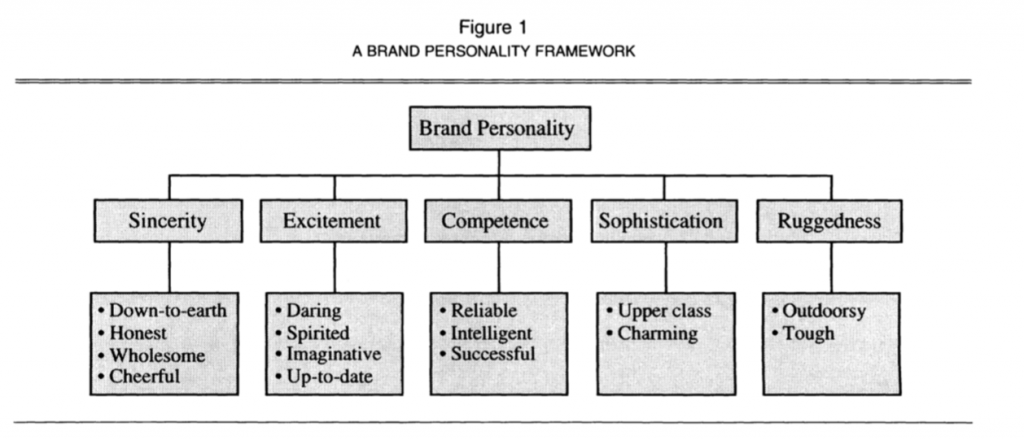Mots clés : brand personality, échelle de mesure, traits de personnalité, marque
Beaucoup de recherches ont été effectuées sur la personnalité humaine, cependant selon l’auteur, il existait peu de travaux sur la conceptualisation d’une « brand personnality ». Dans cet ouvrage, l’auteur se concentre donc sur la construction de personnalité de marque en déterminant 5 dimensions : la sincérité, l’excitation, la compétence, la sophistication et la robustesse.
DÉVELOPPEMENT
La personnalité est une clé de différentiation d’une marque dans un environnement compétitif. Selon l’auteur, la personnalité de marque peut être définie comme l’ensemble des caractéristiques humaines associées à une marque. Par exemple, la marque Absolut Vodka peut avoir les caractéristiques suivantes : cool, contemporaine, 25 ans.
Les consommateurs ont plus de facilité à penser à une marque si des caractéristiques précises lui sont attribuées. De plus, si un consommateur se reconnaît dans les caractéristiques d’une marque, la préférence sera d’autant plus marquée.
La personnalité d’une marque est formée dans l’esprit d’un consommateur par tous les contacts, directs ou indirects, qu’il a eu avec cette marque (Pluller 1985).
Pour examiner comment la personnalité de marque impacte la préférence consommateur, l’auteur présente deux types d’échelles de personnalité de marque. La première est une échelle ad hoc, composée de plusieurs traits de personnalité déjà définis. Cependant, ce type d’échelle est souvent utilisée pour des études spécifiques et certains traits de personnalités peuvent manquer. La deuxième échelle se base sur des traits de personnalité humains et n’a pas été validée dans le contexte de marque. Certains traits peuvent ne pas être applicables aux marques et la validité de cette échelle est donc questionnable.
L’auteur présente ensuite le travail effectué pour définir un ensemble de traits de personnalité valides pour appuyer son contenu. Plusieurs listes de traits ont été établis à partir de différentes sources, notamment le « Big Five » qui regroupe des traits de personnalité humains.
Après avoir défini une liste précise de traits de personnalité, plusieurs études ont ensuite été menées sur des candidats, avec un grand nombre de marques connues. L’objectif ici était de définir une échelle valide soutenue par des résultats précis.
De cette étude, 5 dimensions ont été déterminées : la sincérité, l’excitation, la compétence, la sophistication et la robustesse. Après avoir analysé chacune de ces dimensions séparément, 15 facettes au total en sont ressorties (ex : la sincérité a 4 facettes, la sophistication a 2 facettes etc…). C’est à partir de ces 5 dimensions et 15 facettes que la « Brand personnality scale » peut être définie.

Pour résumer l’étude, l’objectif était de définir différentes dimensions de personnalité de marque. Au total, 631 candidats ont participé à cette étude sur 37 marques et 114 différents traits de personnalité. Les résultats ont ensuite été soutenus par une seconde étude qui a confirmé la validité du travail.
BIBLIOGRAPHIE
Aaker,JenniferandDurairajMaheswaran(1997), “TheImpactof CulturalOrientationon Persuasion,”Journalof ConsumerRe- search, forthcoming.
and Bemd Schmitt (1997), “The Influence of Cultureon the Self-Expressive Use of Brands,”Working Paper #274, UCLA AndersonGraduateSchool of Management.
Alt, MichaelandSteveGriggs(1988), “CanA BrandBe Cheeky?” MarketingIntelligenceand Planning,4 (6), 9-16.
Bagozzi, RichardP. and Todd F. Heatherton(1994), “A General Approachto RepresentingMultifacetedPersonalityConstructs: Applicationto State Self-Esteem,”StructuralEquationModel- ing, 1 (1), 35-67.
Batra, Rajeev, Donald R. Lehmann,and Dipinder Singh (1993), “The BrandPersonalityComponentof BrandGoodwill: Some AntecedentsandConsequences,”in BrandEquityand Advertis- ing, David A. Aaker and Alexander Biel, eds. Hillsdale, NJ: LawrenceErlbaumAssociates.
Belk, Russell W. (1988) “Possessions and the Extended Self,” Journalof ConsumerResearch,2 (September),139-68.
Bellenger, Danny N., Earle Steinberg, and Wilbur W. Stanton (1976), “TheCongruenceof StoreImageandSelf Image,”Jour- nal of Retailing,52 (Spring), 17-32.
Bentler, Peter M. (1990), “ComparativeFit Indexes in Structural Models,”Psychological Bulletin, 107, 238-46.
Biel, Alexander(1993) “ConvertingImage into Equity,”in Brand EquityandAdvertising,DavidA. AakerandAlexanderBiel, eds. Hillsdale, NJ: LawrenceErlbaumAssociates.
Briggs, Steven (1992), “Assessing the Five-FactorModel of Per- sonality Description,”Journalof Personality,60 (2), 253-93. Chaiken,Shelly and DurairajMaheswaran(1994), “HeuristicPro-
cessing Can Bias Systematic Processing: Effects of Source Credibility,ArgumentAmbiguity,andTaskImportanceon At- tributeJudgment,”Journal of Personalityand Social Psycholo- gy, 66 (3), 460-73.
Church,TimothyA. and PeterJ. Burke(1994), “Exploratoryand ConfirmatoryTests of the Big Five and Tellegen’s Three and Four-DimensionalModels,”Journal of Personalityand Social Psychology,66 (1), 93-114.
Churchill,GilbertA., Jr.(1979), “A Paradigmfor Developing Bet- ter Measures of MarketingConstructs,”Journal of Marketing Research, 16 (February),64-73.
Digman,JohnM. (1990), “PersonalityStructure:Emergenceof the Five-Factor Model,” Annual Review of Psychology, 41, 417-40.
Dolich, IraJ. (1969), “CongruenceRelationshipBetween Self-Im- age and Product Brands,”Journal of Marketing Research, 6 (February),80-84.
Epstein,Seymour(1977), “TraitsareAlive andWell,”in Personal- ityat the Crossroads,D. MagnussonandN.S. Endler,eds. Hills- dale, NJ: LawrenceErlbaumAssociates, 83-98.
EquiTrend(1992), TotalResearchCorporation,Princeton,NJ. Everett,John E. (1983), “FactorComparabilityas a Means of De- termining the Number of Factors and Their Rotation,”Multi-
variate BehavioralResearch, 18, 197-218.
Fishbein, Martinand Icek Ajzen (1975), Belief, Attitude,Intention
and Behavior:An Introductionto Theoryand Research.Read-
ing, MA: Addison-Wesley.
Fournier,Susan (1994), “A Consumer-BrandRelationshipFrame-
work for Strategy Brand Management”unpublisheddoctoral
dissertation,Universityof Florida.
Gilmore, George W. (1919), Animism. Boston: Marshall Jones
Company.
Halliday,Jean(1996), “Chrysler Brings Out Brand Personalitie with ’97 Ads,”Advertising Age (September30), 3.
John, Oliver (1990), “The ‘Big Five’ FactorTaxonomy:Dimen- sions of Personalityin the NaturalLanguageand in Question- naires,”in Handbookof Personality:Theoryand Research,L.A.
Pervin,ed. San Francisco:Harper,66-100. Kassarjian,HaroldH. (1971), “Personalityand ConsumerBehav-
ior:A Review,”Journalof MarketingResearch,8 (November)
409-18. Katz,Daniel(1960),”TheFunctionalApproachtotheStudyofAt-
titudes,”Public OpinionQuarterly,24, 163-204.
Keller, Kevin L. (1993), “Conceptualizing,Measuring,and Man- aging Customer-BasedBrandEquity,”Journalof Marketing,57
(January),1-22.
Kleine, Robert E., Susan Schultz Kleine, and Jerome B. Kernan
(1993), “MundaneConsumptionand the Self: A Social-Identity
Perspective,”Journalof ConsumerPsychology,2 (3), 209-35. Kleine,SusanSchultz,RobertE. KleineIII,andChrisT.Allen
(1995), “How Is a Possession ‘Me’ or ‘Not Me’? Characterizing Types and an Antecedent of MaterialPossession Attachment,” Journalof ConsumerResearch,3 (December),327-43.
Levy,SidneyJ.(1959),”SymbolsforSales,”HarvardBusinessRe- view,37 (4), 117-24.
Maheswaran,Durairajand Shelly Chaiken (1991), “Promoting SystematicProcessingin Low MotivationSettings:Effectof In- congruentInformationon ProcessingJudgment,”Journalof Per- sonality and Social Psychology,61, 13-25.
Malhotra,Naresh K. (1981), “A Scale to MeasureSelf-Concepts, PersonConceptsandProductConcepts,”Journalof Marketing Research,23 (November),456-64.
(1988), “SelfConceptandProductChoice:An Integrated Perspective,”Journalof EconomicPsychology,9, 1-28.
Markus,Hazel(1977), “Self-SchemataandProcessingInformation About the Self,” Journal of Personalityand Social Psychology, 35 (2), 63-78.
and Shinobu Kitayama(1991), “Cultureand the Self: Im- plicationsfor Cognition,EmotionandMotivation,”Psychology Review,98, 224-53.
andElissaWurf(1987), “TheDynamicSelf-Concept:A Social Psychological Perspective,”AnnualReviewof Psycholo- gy, 38 (2), 299-337.
McCracken,Grant(1989), “Who Is the CelebrityEndorser?Cul- turalFoundationsof the EndorsementProcess,”Journalof Con- sumerResearch, 16 (3), 310-21.
McCrae,RobertR.andPaulT.Costa,Jr.(1989), “TheStructureof InterpersonalTraits: Wiggins’s Circumplex and Five-Factor
Model,”Journal of Personalityand Social Psychology, 56 (4),
586-95.
Norman, WarrenT. (1963), “Towardan Adequate Taxonomy of
PersonalityAttribute:ReplicatedFactorStructurein Peer Nom- ination PersonalityRatings,”Journal of Abnormaland Social Psychology,66, 574-83.
Nunnally,JumC.(1978), PsychometricTheory.NewYork:Mc- Graw-Hill,Inc.
Osgood, Charles E., George J. Suci, and Percy H. Tannenbaum (1957), The Measurementof Meaning. Chicago: Universityof Illinois Press.
Park,Bemadette(1986), “A Methodfor Studyingthe Development of Impressionsof Real People,”Journal of Personalityand So- cial Psychology,51, 907-17.
Paunonen,SampoV.,DouglasN. Jackson,JerzyTrzebinski,and FriedrichForsterling(1992), “PersonalityStructureAcross Cul- tures: A MultimethodEvaluation,”Journal of Personalityand Social Psychology,62 (3), 447-56.
Pendergrast,Mark(1993), ForGod,CountryandCoca-Cola.New York:CharlesScribner’sSons.
Piedmont, Ralph L., Robert R. McCrae, and Paul T. Costa, Jr. (1991),”AdjectiveCheckListScalesandtheFive-FactorModel,” Journalof Personalityand Social Psychology,60 (4), 630-37.
Plummer,JosephT. (1985), “BrandPersonality:A StrategicCon- cept For MultinationalAdvertising,”in MarketingEducators’ Conference.NewYork:Young&Rubicam,1-31.
Ratchford, Brian (1987), “New Insights About the FCB Grid,” JournalofAdvertisingResearch,27(August/September)2,4-26. Rook, DennisW.(1985), “TheRitualDimensionof ConsumerBe- havior,”Journalof ConsumerResearch,12(December),251-64.
Sirgy, Joseph (1982), “Self-Concept in Consumer Behavior: A CriticalReview,”Journalof ConsumerResearch,9 (December) 287-300.
Tupes, ErnestC. and RaymondE. Christal(1958), “Stabilityof PersonalityTraitRatingFactorsObtainedUnderDiverseCondi- tions,”USAFWADSTechnicalReportNo.58-61. LacklandAir Force Base, TX: U.S. Air Force.
Wells,William,FrankJ.Andriuli,FedeleJ.Goi, andStuartSeader (1957), “An Adjective Checklist for the Study of ‘ProductPer- sonality,”‘Journalof AppliedPsychology,41, 317-19.
